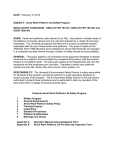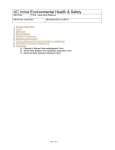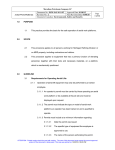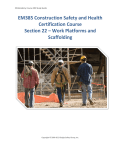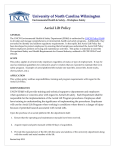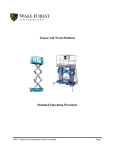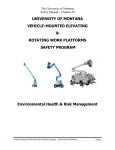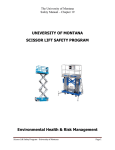Download aerial and scissors lift policy
Transcript
HOPE COLLEGE AERIAL PLATFORM AND SCISSOR LIFT POLICY Aerial Platform & Scissor Lift Policy – Hope College June, 2011 1 Table of Contents I. Introduction 3 II. Scope 3 III. Responsibilities 3 IV. Training Program 6 Appendix A Specific Lift Familiarity Training Certification Form 8 Appendix B Aerial Platform & Scissor Lift Pre-Start up Inspection Form 9 Appendix C Aerial Platform & Scissor Lift Workplace Inspection Form 10 Appendix D Operating Manual Acknowledgment Form 11 2 I. Introduction Aerial platform and scissor lifts are present throughout the campus of Hope College and are used and operated by a number of college staff and student members. Hope College recognizes that there are potential hazards associated with the use of these aerial platform lifts. This policy is based on the ANSI/SIA A92.2 through A92.6 Standards (2001 through 2006) and is designed to ensure that these lifts are operated in a consistent and safe manner through a system of safety checks and accountability. II. Scope This policy applies to all College owned or rented aerial platform and scissor lifts designed to elevate personnel on a platform that is propelled by a powered lifting device, with the controls located on the platform itself. It applies to the departments who own or rent the equipment and the employees and students who use them. Examples of aerial platform lifts include vehicle (or trailer) mounted aerial lift/bucket trucks, vertical personnel lifts, scissor lifts, articulating boom aerial lifts, cherry pickers, and extendable/telescoping aerial lifts. Contractors must supply their own lifts and be trained on them or attend a training class to use Hope College lifts. Contract employees must follow the same procedures if using college owned lifts that employees of the college follow. If a contract employee can verify in writing that they have received training on the make and model of lift that they will be using and their certification is current they may use a College lift but must obey the rules of this policy. III. Responsibilities As safety is everyone’s obligation, the responsibilities outlined below are not recommendations; rather these are mandatory requirements per this policy. a. Departmental Managers/Supervisors 1. Ensure that the operating and maintenance manuals have been made available to each operator, placed in a weather-proof compartment on the lift, and that the “Operating Manual Acknowledgement Form” found in Appendix D of this policy has been completed by each operator who uses the lift(s). A copy of this completed form shall be sent to the Health and Fire Safety Office. 2. Contact Great Lakes Access or other authorized party for lift training for all operators prior to the initial use of the lift. This will include classroom training and familiarization and hands on training. 3. Ensure that all employee operators of the lift review the operator’s manual and sign the acknowledgment form prior to initial use of the lift, and receive a certification card from Health and Fire Safety upon completion of their training. 3 4. Appoint an individual within the Department as a designated Safety Contact who will be the point of contact with the Health and Fire Safety Department and operators concerning lift safety. 5. Insure that the inspection and repair of each lift is up to date prior to use. Each lift has an annual inspection tag from an authorized agent on it and must be current for the operator to use the lift. If no tag is present the lift must not be used. The Authorized Agent must inspect the lift according to manufacturer’s recommendations. 6. When renting a lift, the Departmental Safety Contact person must provide lift specific familiarization training conducted by an authorized agent on the specific lift they are renting for the operators. The form in Appendix A shall be signed by each Trainee and the Trainer for proper documentation and the original signed copies shall be sent to the Health and Fire Safety Office. Each rented lift shall require the rental agency to provide a pre-start inspection form for the specific lift that they will be renting as found in Appendix B. 7. Each Department must ensure that no personnel operate an aerial platform lift or scissor lift if they have not been trained in both classroom lift training and familiarization training on the lift type they will be using. 8 When lifts are used outdoors, the Departmental Safety Contract must ensure that weather conditions are continuously monitored through a real time weather service source throughout the use of the lift and that an anemometer (wind velocity meter) is attached on the lift’s personnel platform, is operational, and is visible to the operator. Contact Health and Fire Safety to locate an anemometer. Vertical aerial platform and scissor lifts may not be used when wind speeds reach 28 mph or more, or when there is a weather warning in effect for winds in excess of 28 mph. 9. Records need to be kept on the following: List of people in the Department that received training, including a sign in sheet with names of attendees, the date of training, make and model of lifts trained on, who conducted the training, and the location of training. Also any deficiencies found, corrective actions taken and who made the repairs must be kept. All records must be kept for a minimum of 5 years. 4 b. Employee/Operator Responsibilities Because the operator has direct control over the application and operation of aerial platform or scissor lift, conformance with good safety practices is the obligation of the operator of the lift. Operators of aerial platform and scissor lifts have responsibilities involving the following: Operators of aerial platform and scissor lifts must review the operator’s manual for all lifts that they use. Through the classroom aerial platform lift safety training, specific lift familiarization training and review of the operator’s manual, the operator is expected to know and understand the following about the lifts that they operate, prior to the initial operation of the lift: 1. Safe operation of the lift 2. Hazardous conditions which jeopardize safety. 3. All control features of the lift 4. All placard warnings 5. All safety devices on the lift 6. Where to locate the owners manual 7. Who is permitted to operate or ride on the lift. If the operator does not understand any of the above they shall consult with their supervisor, their Designated Safety Contact, or Health and Fire Safety prior to using the lift to ensure a full understanding. Perform Pre-Start Inspections: Operators shall inspect the aerial platform or scissor lift as required by policy to ensure proper operation. Never operate vertical aerial platform or scissor lift when wind speeds exceed 28 mph, or when lightening is observed. Operator shall notify their supervisor if the lift does not safely pass inspection or if any unsafe condition is identified. c. Health and Fire Safety Responsibilities Health and Fire Safety (H&FS) is responsible to make sure that the Aerial Platform and Scissor Lift Policy is up to date and that the overall program is implemented. In addition H&FS will be responsible for providing qualified trainers for lift training. This may include representatives from the manufacturer, distributor, or other qualified contract trainer. 5 Training records should be kept by each department but a copy of the training records will be kept at the H&FS office. Training records need to be accessible by H&FS in the event of an inspection from an outside agency. IV. Training Program To become authorized to operate an aerial platform or scissor lift, employees must successfully complete an initial two-part training program: 1. A classroom session 2. A specific lift familiarization session. Training certification cards will be issued (every 3 years) to all users who complete these requirements. Each certificate will indicate the specific aerial platform or scissor lift(s) the training participant is approved to operate based on the make and model. Employees are not allowed to operate lifts for which they have not been approved (lifts that they did not receive “specific lift” familiarization training on). Employees who have no need to operate an aerial platform lift but do have a need to ride on a lift with an authorized operator may attend the classroom training session only and will be issued a certificate that allows them be a “passenger only”. a. Classroom safety training: All operators and users of aerial platform lifts shall attend an aerial platform and scissor lift training class using a qualified and authorized trainer approved by Health and Fire Safety prior to using or operating a lift. The contents of the training will include the following: Purpose and use of manuals and where they are located. Pre-start inspection process. Identification of malfunctions and problems. Factors affecting stability. Purpose of placards and decals. Workplace inspections. Safety rules and regulations. Operator warnings and instructions. The application of fall arrest systems for aerial platform and scissor lifts. The use of wind monitoring equipment, including the lift anemometer for outside lift use, and reinforcement of the operator’s authority to come down from the lift if they have any safety concerns. 6 b. Specific Lift Familiarization Training All operators of aerial platform and scissor lifts shall attend a “Specific Lift Familiarization Training” session that is specific to the make and model of lift that they will be operating. The selection of the trainer shall be approved by Health and Fire Safety. The trainer may be a representative of the lift manufacturer, a representative of the lift distributor or a contracted trainer. c. Certificate of Training Successful completion of both the classroom and Specific Lift Familiarization portions of the training will authorize an employee to use the aerial platform or scissor lift. At this time Health and Fire Safety or the Authorized Trainer will issue a certification card to the authorized user of the lift. d. Re-training for unsafe operation or accident Re-training (both the classroom and specific lift familiarization sessions) will be required of any operator that has been involved in an aerial platform or scissor lift incident or when someone has observed them performing unsafe practices involving the lift. This training can be initiated by the Supervisor or Health and Fire Safety. 7 APPENDIX A Hope College Platform or Scissor Lift Certification Form Specific Lift Familiarization Training This form documents the OSHA-Required Aerial Platform or Scissor Lift training that is performed by an approved, competent person. Health and Fire Safety must approve the trainer which is based on his/her experience with the particular lift or his/her safety training experience. The training may also be performed by the lift manufacturer’s or vendors appointed representative or through video that is provided by the manufacturer, specific to the particular lift. Each operator must be trained on each aerial platform or scissor lift that he/she operates. The Specific Lift Familiarization Training shall consist of a review of the following items: a. All safety placards and warnings b. All switches, drive mechanisms, adjustments, and controls (both lower and upper controls) c. The functional operation of the lift. d. The use of outriggers or stabilizing equipment. e. All gauges, horns, and lights. f. Proper battery charging procedures. g. Inspections and inspection process. Aerial or Scissor Lift: Lift Manufacturer (Brand Name) ____________________________________ Model Serial # ________________ __________ I certify that I have met with the trainee identified below and have reviewed the operations of the specific lift identified above and made myself available to answer any questions he/she may have had with regards to the operation of this lift. Print Trainer’s Name Signature of Trainer ____________________________ ____________________________ Date __________ I certify that I have met with the trainer identified above and that he/she has reviewed with me the operations of the specific aerial platform or scissor lift identified above. I was given an opportunity to ask questions which, if any, were answered to my satisfaction and that I now have the necessary understanding of operations of this lift. I have reviewed the operator’s manual for this lift and have been given the opportunity to ask questions that I have had. Print the Trainee’s Name Signature of Trainee Date _____________________________ _____________________________ __________ 8 Appendix B Aerial Platform & Scissor Lift Pre-start Inspection Form The pre-start inspection shall be performed prior to each day’s or shift’s use of the aerial platform lift by an authorized employee and trained operator of the lift. Documentation of the inspection shall be maintained by each department, with a copy of the most recent inspection document stored on the lift. Check off the items that have been inspected or mark the N/A box if the item does not apply to the lift being inspected. Place any comments in the space provided below. If there are any of these items that are not satisfactory, place the lift out of service until the item is corrected. Make of Lift __________ Model of Lift ___________ Serial # _________________ Inspectors Name ____________________________ Item Inspected Date of Inspection ___________ OK Not OK N/A Operating controls Emergency controls Safety devices Personal protective devices Pneumatic systems (leaks) Hydraulic system ( leaks) Fuel System ( leaks) Cables Wiring harness Loose/ missing parts (lock pins/bolts …) Tires and wheels Placards and warnings Operational manual available Outriggers/Stabilizers Guardrail system and locking gate Anemometer present (if using outdoors) Other items Comments: __________________________________________________________ Inspectors Signature ________________________________________Date _______ 9 Appendix C Aerial Platform & Scissor Lift Workplace Inspection Form The workplace inspection shall be performed prior to using the aerial platform lift. One inspection may be performed for multiple tasks taking place in a single room or space per day. Check off the items that have been inspected and abate any safety issues that were identified prior to using the lift. Item observed Drop-offs or holes Slopes Bumps and floor obstructions Debris Overhead obstructions and high voltage conductors. Inadequate surface and support to withstand all load forces imposed by aerial lift platform. Wind and weather conditions if being used outdoors are safe. Wind speeds Below 29 mph and no lightening or severe weather forecasted. Presence of other unsafe conditions. Inspectors Name _______________________________________ Date _____________ 10 Appendix D Operating Manual Acknowledgement Form By signing this document, I am certifying that I have received a copy of the operations manual for the aerial platform lift shown below. Upon training and authorization by my department, I am expected to operate this lift in accordance with the safety rules and procedures outlined in the owner’s manual. I under that if, at any time, I have any questions regarding the information found in the user’s manual, I can contact Health and Fire Safety, my supervisor, or the manufacturer to obtain answers. Aerial Lift Make ____________________________ Aerial Lift Model _____________ Name (print) ____________________________________________________________ User/Operator’s Signature ___________________________________ Date __________ 11











